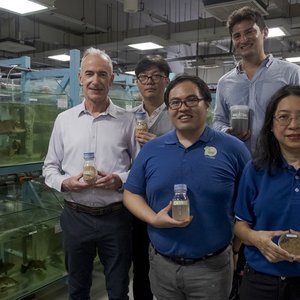Celebrating the launch event of the Zimbabwe Fish Producers Association
Fish farming is a livestock enterprise in its own right and must be developed into a fully- fledged agricultural industry in Zimbabwe. This was highlighted at the launch of the Zimbabwe Fish Producers’ Association (ZFPA) at Exhibition Park on 17 March, which attracted a turnout of 220, eager to find out more about fish production. The formation of ZFPA formally brings aquaculture into agriculture as part of the livestock sub-sector.
The establishment of ZFPA comes as Zimbabwe works to develop a fish capacity building strategy, under the EU-funded SmartFish programme. In a project co-implemented by FAO, OIC SmartFish is working with the Ministry of Agriculture, Mechanisation and Irrigation Development to develop the country’s aquaculture potential, so that Zimbabwe can also reap the benefits of the global Blue Revolution.
Aquaculture - the world’s fastest growing food industry - can be developed into a major industry in landlocked Zimbabwe, at both small-scale and large-scale levels. The country holds 60% of all dammed water in the SADC region and boasts the largest freshwater fish farm in Africa; but less than 5% of the 400 000 hectares suitable for inland aquaculture is currently being utilised for fish production. Currently concentrated in commercial tilapia operations on Lakes Kariba, Chivero and Darwendale, and rainbow trout farming around Nyanga, aquaculture remains largely undeveloped.
“Fish farming in Zimbabwe is still in its infancy”, Gerry McCollum, Interim Chairman of ZFPA noted at the launch of the association. “Fish is an industry that people can get involved in and realize the enormous potential that exists for fish farming here in Zimbabwe.
We have fabulous water resources, perfect climatic conditions for fish farming. We have all the inputs, the right feed to grow fish commercially and we need to take advantage of this to grow aquaculture into a very strong and burgeoning industry in Zimbabwe.”
Government is ready to partner ZFPA to ensure the success of fish farming in Zimbabwe, said Mr Makodza at the launch event on behalf of the Permanent Secretary in the Ministry of Agriculture. Mechanisation and Irrigation Development. By recognizing that fish are livestock, to be farmed commercially for food production, and not just conserved in their wild state for capture, government has classified aquaculture as part of the livestock sub- sector.
Fish can be farmed intensively; they are efficient converters of feed into protein for human consumption. Aquaculture is a form of commercial farming that is non-consumptive in its use of water and can be integrated into crop production or other livestock farming. Fish farming has an important role to play in Zimbabwe, in drought mitigation, agricultural production for sustainable livelihoods and food security, as well as contributing to economic development through processed fish exports.
Aquaculture is the fastest growing agricultural industry globally. Fish have the highest food conversion ratios - they produce more protein per kg of feed. To assist small-scale farmers to enter the industry, ZFPA is working to make all the required inputs and services accessible to farmers in one package. “We plan to roll out the same model used in the broiler industry, to support small-scale producers with the full package of inputs, and to provide farming advice” explains Gerry McCollum.
The vision to grow aquaculture in Zimbabwe will focus on developing fish farming in areas with greatest production and marketing potential, greater utilisation of the abundant water resources; and the growing of commercial small holder aquaculture in the country. Where there are no water bodies, there is scope for pond construction, the basis of commercial smallholder fish farming in Asia.
In the warmer areas of Zimbabwe, not as well suited to other forms of agriculture, fish can be introduced as an alternative form of commercial farming. Aquaculture can play a complementary role in the fish industry too, augmenting livelihoods of capture fisherman whose catches have been steadily declining over the last decade.
ZFPA is working to develop a regulatory framework for aquaculture in Zimbabwe, one of the few countries in Africa that does not yet have one, and to harmonise all legislation relating to fish and aquaculture. “We also need to establish production standards and benchmark against other countries”, says Gerry McCollum.
The development in Zimbabwe of a specialised fish feeds industry in recent years has improved tilapia growth rates for the commercial farming of Africa’s indigenous fish, suited to high stocking in dams and ponds. Another key development is the Aquaculture Quality Control Laboratory in Harare, to be equipped with EU funding under the SmartFish program. In a programme of technical assistance to Zimbabwe started in 2012, SmartFish has provided training in aquaculture; value chain and business development support; as well as trade and marketing studies and promotion.
Calling on Zimbabwe to emulate the example of some other African countries SmartFish Programme Fisheries and Aquaculture Advisor, Dr Blessing Mapfumo told the ZFPA launch gathering “fish production requires the creation of an enabling environment.” The continent’s top six fish producers, Namibia, Zambia, Kenya, Ghana, Uganda and South Africa have invested in aquaculture development; with stimulus policies and development programs building strong aquaculture industries in these countries.







